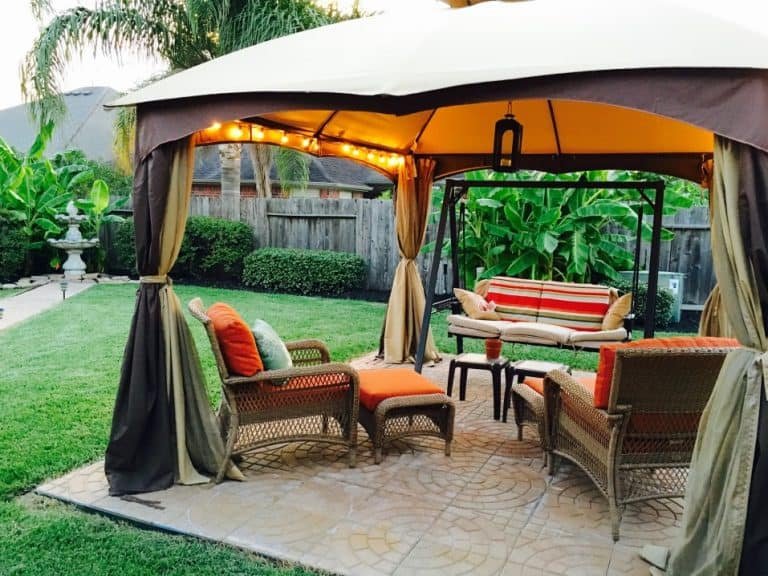How to Make A Gazebo Cover
Whether your old one wears out, or you simply never had one, you might be in the market for a new gazebo cover. Thankfully, making a gazebo cover yourself isn’t too hard, but it does take some know-how.
The easiest way to make a homemade gazebo cover is to trace the old one, if you still have it. If you don’t have the original cover, you will need to measure the dimensions yourself and use a suitable material like canvas.
While this may seem like a simple task, it can get quite involved. There are factors like what material to use or how to actually install it once you get it finished may. So, let’s take a look at some of the essential details of the job.
Table of Contents
Making a DIY Gazebo Cover at Home
Making a cover for something as large as a gazebo can seem like a daunting task, but it’s actually not too bad. The first thing you’ll need are the proper tools to get the job done.
Thankfully, the tools you’ll need are simple everyday hand tools that are most likely hung up in your garage or stored away in a drawer somewhere:
- First, you’ll need a pair of sharp shears so that you can make smooth straight cuts without fraying the material. They do make a rotary tool specifically for cutting canvas, which is nice to have but not necessary.
- You’ll need a marker to trace the old cover. If you don’t have one on hand, you can use the old cover as a stencil and cut around it. If you don’t have the old cover, still grab a marker for taking measurements.
- A tape measure will also be necessary if you no longer have the old cover.
- You’ll need a ladder if you’re planning on getting and installing the cover. Make sure that it’s sturdy and all of the rung’s welds are intact. Make sure to follow all ladder safety rules.
- Lastly, and most importantly, you’ll need a sewing kit along with a little bit of sewing ability. The cover gets sown to the gazebo; you may also want to seam up the end or maybe give it a personal touch.
- As a side note: it’s completely ok to cheat! Hand stitching the seams around the edge of your covering can consume a lot of your time. So, if you got a sewing machine, you’re going to want to use it.
How to Make a Gazebo Cover
Thankfully, making the cover isn’t a very complicated task if you know what you’re doing. Let’s go over how to do it, step by step.
Prepare the Old Cover for Tracing
The first step is just to prepare the old cover for tracing. Be warned that this will “damage” the old cover, so only start this process once you’re ready to go ahead with making the new one right away.
After removing it from the gazebo, carefully cut all the stitching. This will allow it to be unfurled and laid flat. Otherwise, it will be near impossible to get accurate tracings from it and would be a big headache.
The old cover isn’t permanently destroyed, it can be stitched back together later.
Trace the Old Cover
The second step is to use to the old cover to size the new one:
- First, start by laying the new fabric out on a flat surface. A driveway or other rigid surface is best, but you can also make do with a lawn if needed—just be extra careful to get the proportions right when tracing because the fabric will squish into the grass.
- Next, lay the old cover on top of it and stretch it flat, then begin tracing with a marker. Having an assistant will help out a great deal here. They can hold the material still while you trace the outline.
Make sure the marker you are using is water soluble or can be removed some other way. The last thing you want is to permanently mark up your new cover before you even cut it!
If you’re not careful, your marker can slip under the edge of the old cover as your tracing. So, using a hard edge to ensure that your lines stay straight isn’t a bad idea either.
Cut Out the New Cover
Next, break out those fabric shears and get to work.
Carefully use the shears to cut as straight as possible around the tracing. Having an assistant would be very useful as they can hold the fabric taught while you cut.
When your cutting free your new cover, don’t worry so much about being exactly on the line. In fact, leave some extra material around the outline. Once the general shape is cut out, go back and trim up the edges to be flush with the tracing.
Sew It Up
This is where the sewing kit comes in.
- First, you’ll need to make a one-inch hem at its edges to keep it from fraying. You should use a heavy, waterproof fabric and give the hem a double stitch for some added strength.
- Next, simply use the first cover as a blueprint as you sew the new one up. Depending on your gazebo and how intricate the first cover was, this could be simple or quite complex.
It’s a good idea to use double stitching. It’ll give your cover some added strength and possibly add some years to its life span.
If you have a sewing machine on hand, then, by all means, use it. Hand stitching can be very time consuming and labor-intensive.
What If I Don’t Have the Old Cover?
If you don’t have the old covering, that’s no big deal. We can still get the measurements. Using the ladder and the tape measure, you can get the dimensions.
You’ll need two measurements, one from the front of the gazebo and another from the side. Mark it out on the new material adding about two inches, and draw out the lines using anything with a straight edge.
Installing Your New Cover
You are going to need a helper for this part of the project. While it’s possible to do alone, having a helper will remove a lot of time and frustration.
Basically, you’re going to want your assistant to help you center the new cover on top and in the rough position you want it.
Once you have the canvas where you want it, it’s time to sew it up to fully attach. Have your assistant steady the canvas on the opposite side of you to keep it from stretching while you sew the remaining seams into place.
Alternatively, you can work a lacing system into the design as you plan the new cover, then use leather or other cordage to lace it down tight.
What Materials Are Best to Use
There are a couple of materials you can use for this project. They each have their strengths and weaknesses. Choosing one will depend on whether you want quick, easy, and cheap or something that will last a long time and be considerably durable.
Canvas Is Tough
Canvas coverings come with various benefits; they bend and stretch so they won’t tear easily. Canvas also does a pretty good job of blocking out the sun, so it’ll keep you cool and shaded. It’s a very tough material and an excellent choice for your gazebo.
If you’re going to use canvas, keep in mind that you have to make sure it’s pulled tight, or it could sag and look very sloppy. The fabric also requires a little more effort to keep clean than some of the others.
Pros
- Aesthetically pleasing
- Resistant to tearing
Cons
- Harder to install
- Harder to keep clean
Vinyl Is Easily Maintained
Vinyl coverings are low maintenance and durable, so they’ll last some time without needing much attention. Vinyl will also keep out those harmful UV rays and keep you comfortable while you enjoy the day. While vinyl is an excellent material, it isn’t as pleasant to the touch. Vinyl is a hard, slightly abrasive material.
Pros
- Durable
- Low maintenance
Cons
- A harder material that’s not aesthetically pleasing
Acrylic Fabric Is Extremely Long-Lived
This is a very tough material, so much so that many manufactures offer a ten-year warranty. It’s also low maintenance taking minimal effort to clean. Another plus with this product is that it comes in an assortment of colors.
As durable as this material is, it is also prone to getting scratches and other surface imperfections. These won’t affect the durability of the material, but they may look ugly if they add up over time.
Pros
- The most durable
- Easiest to clean
Cons
- Easier to scratch than glass
- The hardest to install
DIY Gazebo Covers
Making a replacement cover can be very cost-effective. Some people may even have a few of the materials sitting around their home. Even if you don’t, the material isn’t expensive, and you can purchase it at nearly any hardware store.
Making your gazebo covering isn’t a super-challenging project, so it’s perfect for someone who wants to get some practice being a little crafty or for those who want to give their gazebos a personal touch.
We also have articles that are very helping in teaching you how to secure your gazebo against wind and how you can anchor the gazebo to create more stability!






Thanks a lot was helpful. Would be more helpful if you could provide advice about how to cut out the tracings economically to avoid wastage so as to provide knowledge of the minimal material that one should purchase and how to make the most out of it, say as for a 3×6 gazebo which i intend to do.